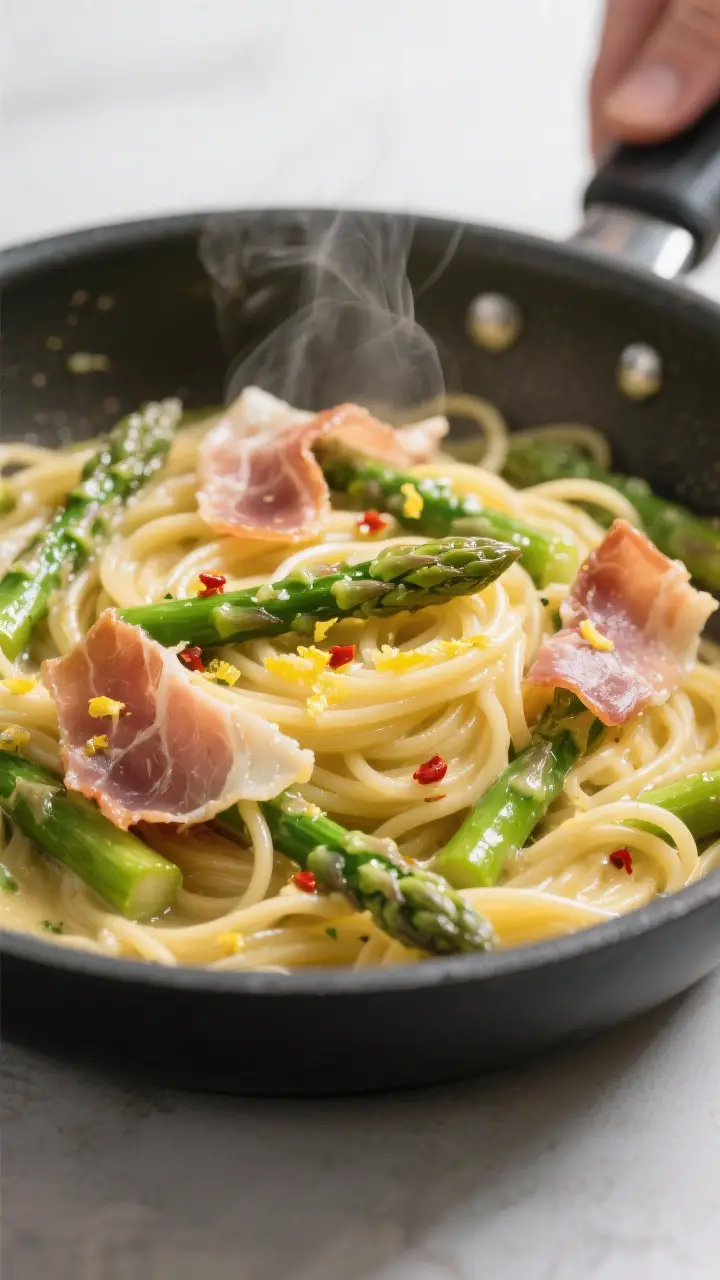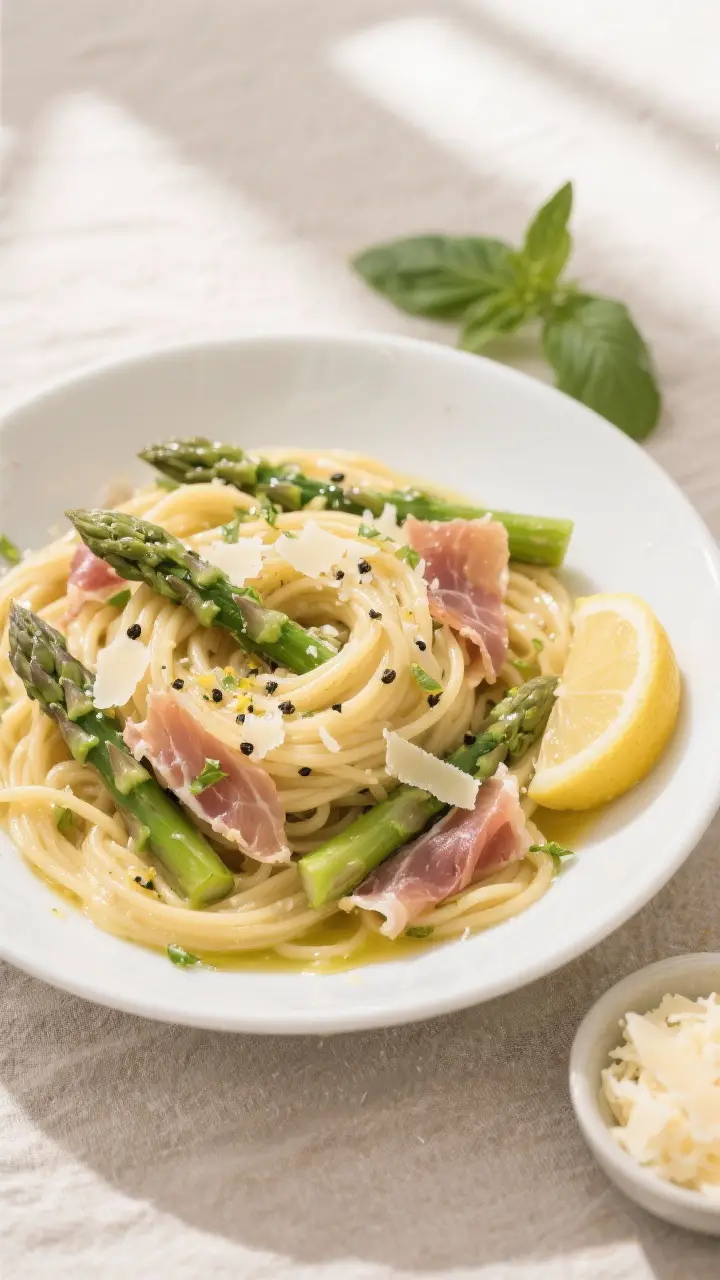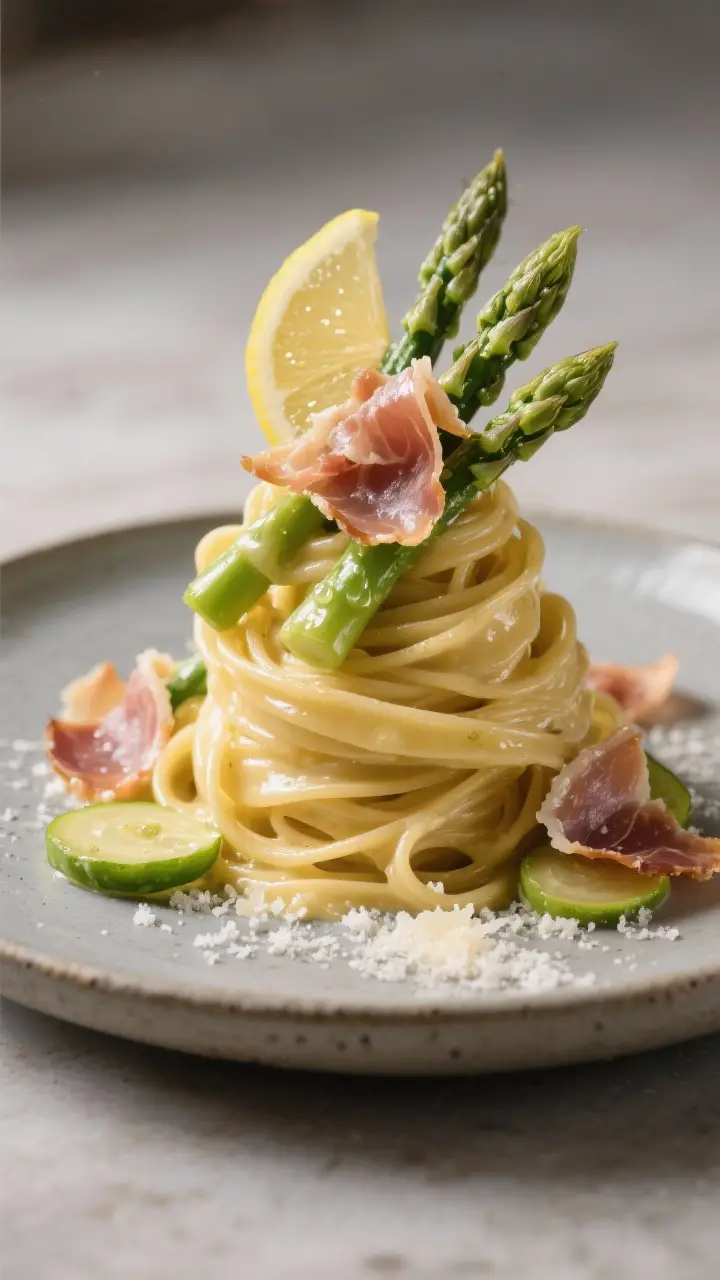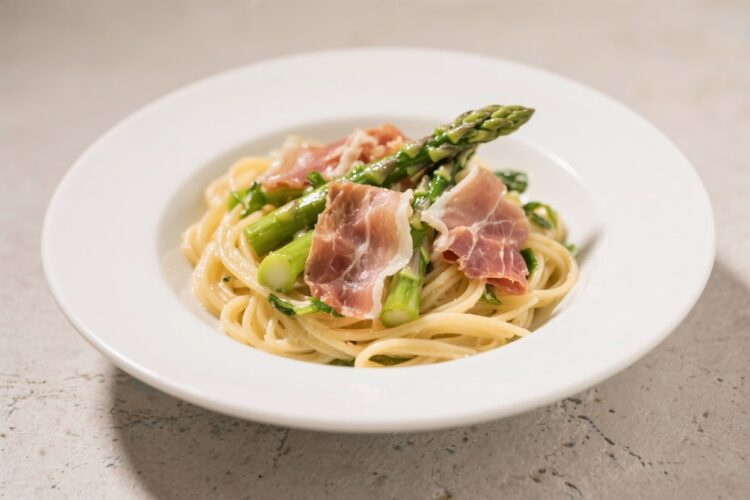This is the kind of pasta you make when you want something special without fuss. Crisp-tender asparagus, salty prosciutto, and a silky, lemony sauce cling to twirls of pasta in a way that feels both comforting and fresh. It’s quick enough for a Tuesday and elegant enough for guests.
Everything cooks in stages while the pasta boils, and it all comes together in one pan at the end. The result is balanced, bright, and deeply satisfying.
Why This Recipe Works

- Simple flavors, big payoff: Asparagus and prosciutto do most of the heavy lifting, bringing sweet, grassy notes and savory depth.
- Starchy pasta water magic: A splash of cooking water emulsifies with butter and olive oil to make a glossy, light sauce that coats every strand.
- Layered texture: Tender pasta, crisp-edged prosciutto, and just-cooked asparagus create contrast in every bite.
- Lemon and parmesan lift: Bright citrus and nutty cheese sharpen the flavors and keep the dish from feeling heavy.
Ingredients
- 12 ounces dried pasta (spaghetti, linguine, or fettuccine)
- 1 pound asparagus, woody ends trimmed, cut into 1- to 1.5-inch pieces
- 4–6 ounces prosciutto, thinly sliced and torn into bite-size strips
- 3 tablespoons olive oil, divided
- 2 tablespoons unsalted butter
- 3 cloves garlic, thinly sliced
- Zest of 1 lemon, plus 2–3 teaspoons fresh lemon juice
- 1/2 cup freshly grated Parmesan or Pecorino Romano, plus more for serving
- 1/2–3/4 cup reserved pasta cooking water
- 1/4 teaspoon red pepper flakes (optional)
- Kosher salt and freshly ground black pepper
- Handful of fresh parsley or basil, chopped (optional)
Step-by-Step Instructions

- Boil the pasta: Bring a large pot of well-salted water to a rolling boil. Add the pasta and cook until just shy of al dente. Reserve at least 1 cup of pasta water before draining.
- Blanch the asparagus (optional but helpful): During the last 2 minutes of pasta cooking, add the asparagus pieces to the pot.
Scoop them out with a slotted spoon and set aside. This step ensures tender-crisp asparagus without extra pans.
- Crisp the prosciutto: In a large skillet over medium heat, warm 1 tablespoon olive oil. Add the prosciutto and cook, stirring, until the edges crisp slightly, 2–3 minutes.
Transfer to a plate. Don’t wipe out the skillet—you want that flavor.
- Sauté the aromatics: Add remaining 2 tablespoons olive oil and the butter to the same skillet. When melted and foamy, add garlic and red pepper flakes.
Cook 30–60 seconds until fragrant, not browned.
- Add asparagus: Stir in the blanched asparagus, season with salt and pepper, and toss for 1–2 minutes to coat and warm through. If you skipped blanching, cook the asparagus here for 4–5 minutes until crisp-tender.
- Build the sauce: Add 1/2 cup reserved pasta water and the lemon zest. Simmer for 30–60 seconds to emulsify.
The liquid should look slightly creamy and cohesive.
- Toss with pasta: Add the drained pasta to the skillet and toss vigorously. Sprinkle in the cheese a little at a time, tossing as it melts into the sauce. Add more pasta water, a splash at a time, until the sauce lightly coats the noodles.
- Finish with prosciutto and lemon: Fold in the crispy prosciutto.
Add lemon juice to taste for brightness. Adjust salt and pepper, then toss in herbs if using.
- Serve: Twirl into bowls and finish with extra cheese, black pepper, and a drizzle of olive oil if you like.
Keeping It Fresh
- Timing is everything: Add asparagus near the end so it stays bright and crisp.
- Use the pasta water: It’s your built-in sauce base. Save more than you think you need.
- Finish at the stove, not at the table: Toss the pasta, cheese, and water together in the pan so the sauce forms before serving.
- Serve immediately: The sauce is silkiest right off the heat.
If it tightens, add a splash of hot water and toss again.

Why This is Good for You
- Asparagus brings fiber and folate: It’s also rich in vitamins A, C, and K, supporting immunity and bone health.
- Olive oil over heavy cream: You get healthy fats and a lighter feel without sacrificing flavor.
- Protein boost from prosciutto and cheese: They add satiating protein and savory intensity, so smaller portions still satisfy.
- Lemon for brightness, not sugar: Clean acidity lifts the dish without added heaviness.
Pitfalls to Watch Out For
- Overcooking asparagus: It should stay bright green and slightly crisp. Dull color means it’s gone too far.
- Skipping the pasta water: Without it, the sauce can be dry and clumpy.
- Adding cheese too quickly: Dumping it all at once can create clumps. Sprinkle in gradually while tossing.
- Too much salt: Prosciutto and cheese are salty.
Taste before seasoning aggressively.
- Dry prosciutto: Cook it just until edges crisp. Overcooking makes it tough and bitter.
Recipe Variations
- Creamy lemon version: Add 1/3 cup heavy cream after the garlic step and simmer 1–2 minutes before adding pasta water. Rich but still bright.
- Spring greens: Fold in peas, baby spinach, or arugula in the last minute of cooking for extra freshness.
- Go nutty: Toasted pine nuts or slivered almonds add crunch and warmth.
- Citrus swap: Try zest and juice of a small Meyer lemon for a softer, floral note.
- Protein switch: Use crisped pancetta or bacon instead of prosciutto, or add sautéed shrimp for a seafood twist.
- Gluten-free: Use your favorite gluten-free pasta and be generous with pasta water to help emulsify.
- Vegetarian: Skip prosciutto and add sautéed mushrooms or marinated artichokes for umami.
FAQ
Can I make this ahead?
You can prep components ahead—trim and cut asparagus, grate cheese, and slice garlic—but cook and assemble right before serving.
The sauce is best when fresh and silky.
What pasta shape works best?
Long strands like spaghetti or linguine cling to the light sauce nicely. Short shapes like penne or orecchiette also work and hold bits of asparagus and prosciutto well.
How do I stop the cheese from clumping?
Lower the heat, toss the pasta with a splash of hot water, then add cheese gradually while stirring. Keep it moving until glossy.
Is there a dairy-free option?
Use olive oil only and skip the butter and cheese.
Add a spoonful of nutritional yeast and a touch more lemon for depth. A small knob of dairy-free butter can help with gloss.
What if I don’t have prosciutto?
Pancetta or bacon are great substitutes. For a lighter route, use thinly sliced turkey bacon or go vegetarian with sautéed mushrooms.
Can I use frozen asparagus?
Yes.
Thaw and pat dry, then sauté directly in the skillet until heated through and bright. Avoid overcooking to keep texture.
How do I reheat leftovers?
Warm gently in a skillet with a splash of water or broth until loosened and glossy. Avoid the microwave if possible, which can toughen prosciutto.
Wrapping Up
Asparagus and Prosciutto Pasta is proof that a handful of good ingredients can deliver a restaurant-worthy bowl in under 30 minutes.
It’s fresh, savory, and balanced, with just enough richness to feel comforting. Keep this one in your rotation for busy nights and easy entertaining. Once you’ve mastered the base, tweak the variations to suit the season and your mood.
Printable Recipe Card
Want just the essential recipe details without scrolling through the article? Get our printable recipe card with just the ingredients and instructions.

